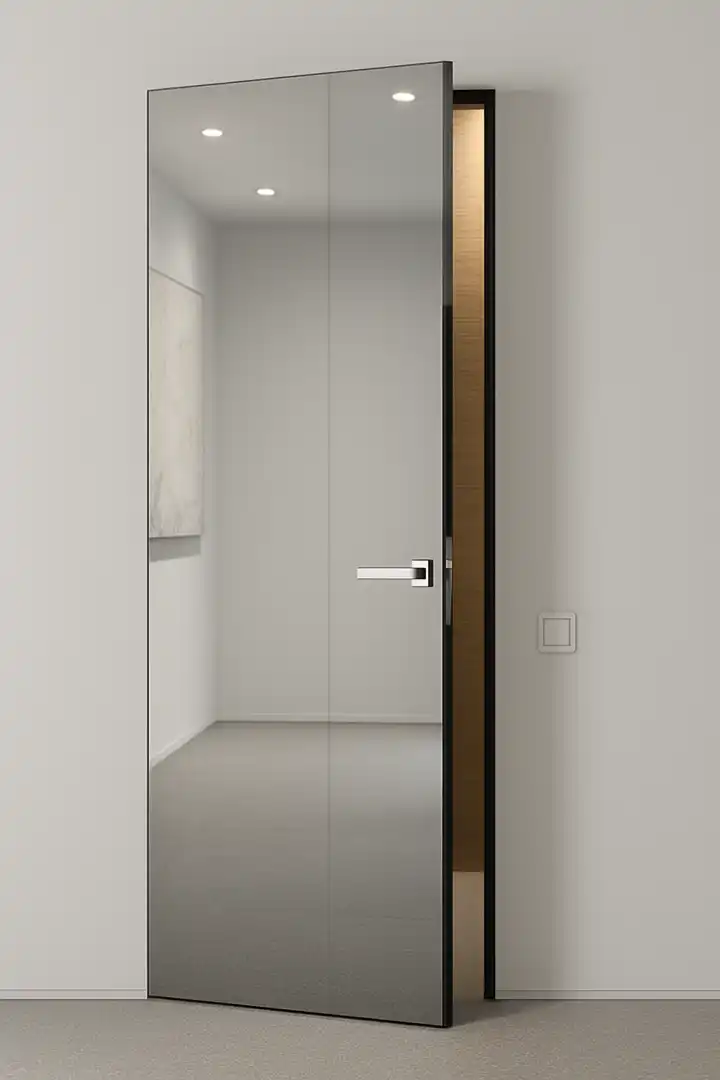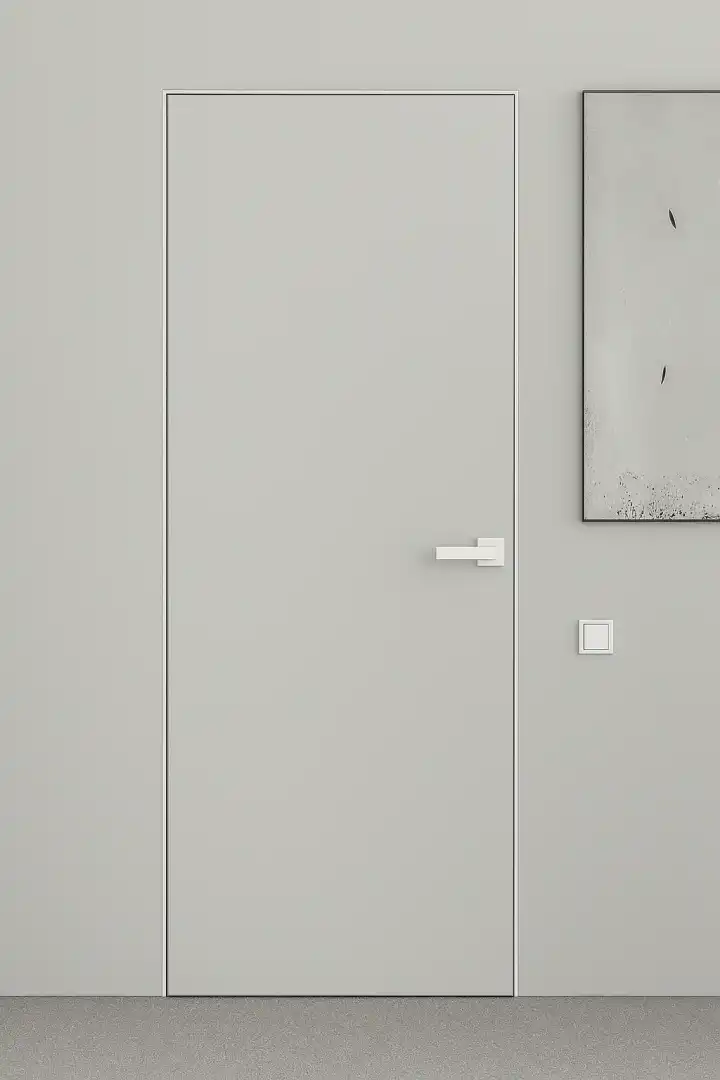Hidden Door in Georgia
Hidden Doors in Architecture: Case Studies and Leading Companies
Hidden doors in Georgia are becoming increasingly popular in contemporary architecture. Their rise in demand is largely due to their ability to create clean lines and minimalist, uncluttered interiors.
These doors, often referred to as “invisible doors,” are seamlessly integrated into the wall structure. They are designed in such a way that they are practically impossible to notice at first glance.
Let’s take a closer look at how invisible doors are implemented in architectural projects — and which companies are leading the way in their production and innovation.
CASE STUDIES IN SPECIFIC BUILDINGS
The Shard, London
One of the most striking examples of hidden door application is the Shard skyscraper in London. This iconic building was designed by world-renowned architect Renzo Piano.
In this project, hidden doors are installed to provide access to technical rooms and office spaces. These doors integrate seamlessly with the interior, blending in without interrupting the visual flow. They help preserve a minimalist and functional aesthetic throughout the space.
One Hyde Park, London
In One Hyde Park, recognized as one of the most prestigious residential complexes in the world, hidden doors play a crucial role in the design.
The interior concept relies on subtle elegance and clean design. Designers selected doors that align with the wall cladding. This creates a seamless aesthetic and gives the rooms a greater sense of openness and sophistication.
Apple Park, Cupertino
At Apple’s global headquarters, Apple Park, hidden doors are an integral part of the architectural philosophy. The building’s interior is designed to reflect Apple’s brand values — simplicity, precision, and innovation.
The hidden doors are embedded into walls made of natural wood and glass, preserving the smooth lines of the structure. This supports the minimalism that defines Apple’s approach to both product and architectural design.
History of hidden doors – Eclisse 1
TECHNOLOGY AND MATERIALS
Hidden door in Georgia
Modern technologies and innovative materials are essential in the development and construction of hidden doors.
Manufacturers use lightweight yet durable materials, such as aluminum and composite panels, which ensure structural strength and longevity. These materials offer excellent stability while maintaining a minimalist form.
Cladding materials vary depending on the interior style. Options include natural wood, glass, and high-end laminates, allowing doors to adapt to virtually any type of decor — from modern to classic.
Invisible doors also feature advanced engineering mechanisms. These include magnetic locks and concealed hinges, which provide smooth, silent operation and enhance user comfort.
Additionally, smart automation systems are becoming more widespread. Doors can now be opened or locked using smartphones or voice assistants, which is especially valuable in smart home environments and high-tech office designs.
Hidden door with aluminum edge
CONCLUSION
The hidden door in Georgia has become a defining feature of modern architectural solutions. These doors enable designers and architects to create clean, minimalist spaces while maintaining full functionality.
Several companies are leading the way in this industry. Notable names include Eclisse, Linvisibile, and Portapivot. These brands are known for delivering high-quality hidden doors with cutting-edge technology and contemporary design.
Hidden doors offer more than just visual appeal. They also improve the functionality, space efficiency, and comfort of the interior. As a result, they are an ideal solution for anyone looking to enhance a space with elegant, innovative elements suited to a modern lifestyle.
-
Hidden doors 220*80 / 90 with ABS surface 59 mm
Original price was: 1149,00 ₾.949,00 ₾Current price is: 949,00 ₾. Select options This product has multiple variants. The options may be chosen on the product page -
Hidden doors 220*80/90 – 42mm ABS surface outward opening
Original price was: 1049,00 ₾.849,00 ₾Current price is: 849,00 ₾. Select options This product has multiple variants. The options may be chosen on the product page -
Hidden doors 220*80/90 ABS surface with black edge, opening outwards
Original price was: 1349,00 ₾.1149,00 ₾Current price is: 1149,00 ₾. Select options This product has multiple variants. The options may be chosen on the product page -
Hidden doors 220*80 / 90 ABS surface with black edge, internal opening
Original price was: 1349,00 ₾.1159,00 ₾Current price is: 1159,00 ₾. Select options This product has multiple variants. The options may be chosen on the product page -
Hidden doors 2300 ABS surface with black edge, internal opening
Original price was: 1590,00 ₾.1249,00 ₾Current price is: 1249,00 ₾. Select options This product has multiple variants. The options may be chosen on the product page -
Hidden doors 2300 ABS surface with black edge, opening outwards
Original price was: 1590,00 ₾.1249,00 ₾Current price is: 1249,00 ₾. Select options This product has multiple variants. The options may be chosen on the product page -
Hidden doors 220*80/90 Black with mirror surface
Original price was: 2363,00 ₾.2210,00 ₾Current price is: 2210,00 ₾. Select options This product has multiple variants. The options may be chosen on the product page -
Hidden doors 220*80/90 Chrome with mirror surface
Original price was: 2268,00 ₾.2150,00 ₾Current price is: 2150,00 ₾. Select options This product has multiple variants. The options may be chosen on the product page -
Hidden doors Zadoor Filomuro Elen PG ALU 40x700x2150 (internal left) 2 hinges Eclipse 2.0
Original price was: 1250,00 ₾.1125,00 ₾Current price is: 1125,00 ₾. Select options This product has multiple variants. The options may be chosen on the product page -
Hidden doors Zadoor Filomuro Elen PG ALU 40x800x2150 (internal right)
Original price was: 1250,00 ₾.1125,00 ₾Current price is: 1125,00 ₾. Select options This product has multiple variants. The options may be chosen on the product page -
Hidden doors Zadoor Filomuro Elen PG ALU 40x800x2150 (outer left)
Original price was: 1250,00 ₾.1125,00 ₾Current price is: 1125,00 ₾. Select options This product has multiple variants. The options may be chosen on the product page -
Hidden doors Zadoor Filomuro Elen PG ALU 40x800x2150 (internal right) 2 hinges Eclipse 2.0
Original price was: 1250,00 ₾.1125,00 ₾Current price is: 1125,00 ₾. Select options This product has multiple variants. The options may be chosen on the product page -
Hidden doors Zadoor Filomuro Elen PG ALU 40x800x2150 (outer left) 2 hinges Eclipse 2.0
Original price was: 1250,00 ₾.1125,00 ₾Current price is: 1125,00 ₾. Select options This product has multiple variants. The options may be chosen on the product page -
Hidden doors 219*78/88 with Black chrome surface on 3 sides
Original price was: 1089,00 ₾.932,00 ₾Current price is: 932,00 ₾. Select options This product has multiple variants. The options may be chosen on the product page -
Hidden doors 219*78/88 with Black chrome internal opening
Original price was: 1189,00 ₾.995,00 ₾Current price is: 995,00 ₾. Select options This product has multiple variants. The options may be chosen on the product page







